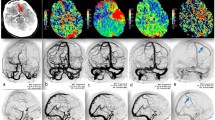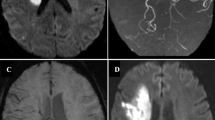Abstract
Objectives
To evaluate tissue perfusion and venous susceptibility in ischaemic stroke patients as a means to predict clinical status and early prognosis.
Methods
A retrospective study of 51 ischaemic stroke patients were enrolled in this study. Susceptibility, perfusion and National Institute of Health stroke scale (NIHSS) were compared between patients with and without asymmetrically prominent cortical veins (APCVs). The correlation between susceptibility, perfusion and NIHSS was performed.
Results
Compared to patients without APCVs, the age of patients with APCVs was statistically older (p = 0.017). Patients with APCVs at discharge showed clinical deterioration in their NIHSS. Mean transit time (MTT), time to peak (TTP) and cerebral blood flow (CBF) in the stroke hemisphere were statistically delayed/decreased in patients with and without APCVs (all p < 0.05). In patients with APCVs, the changes in susceptibility positively correlated with increases in MTT and TTP (p < 0.05). Susceptibility and TTP positively correlated and CBF negatively correlated with NIHSS both at admission and discharge (p < 0.05).
Conclusions
Patients with APCVs have a tendency of deterioration. The presence of APCVs indicates the tissue has increased oxygen extraction fraction. Increased susceptibility from APCVs positively correlated with the delayed MTT and TTP, which reflects the clinical status at admission and predicts an early prognosis.
Key points
• Patients with and without APCVs have similar misery perfusion.
• Patients with APCVs have a tendency of deterioration compared to those without.
• The presence of APCVs indicated the tissue has increased oxygen extraction fraction.
• Increased susceptibility from APCVs positively correlated with the MTT and TTP.
• Increased susceptibility from APCVs reflected the clinical status at admission.





Similar content being viewed by others
Abbreviations
- APCVs:
-
Asymmetrical prominent cortical veins
- DWI:
-
Diffusion-weighted imaging
- MRA:
-
Magnetic resonance angiography
- NIHSS:
-
National Institutes of Health Stroke Scale
- OEF:
-
Oxygen extraction fraction
- PWI:
-
Perfusion-weighted imaging
- rCBF:
-
Relative cerebral blood flow
- rCBV:
-
Relative cerebral blood volume
- rMTT:
-
Relative mean transit time
- rSus:
-
Relative susceptibility
- rTTP:
-
Relative time to peak
- SWI:
-
Susceptibility weighted imaging
- SWIM:
-
Susceptibility weighted imaging and mapping
- VOI:
-
Volume of interest
References
Chen CY, Chen CI, Tsai FY, Tsai PH, Chan WP (2015) Prominent vessel sign on susceptibility-weighted imaging in acute stroke: prediction of infarct growth and clinical outcome. PLoS One 10:e0131118
Polan RM, Poretti A, Huisman TA, Bosemani T (2015) Susceptibility-weighted imaging in pediatric arterial ischemic stroke: a valuable alternative for the noninvasive evaluation of altered cerebral hemodynamics. AJNR Am J Neuroradiol 36:783–788
Park MG, Yang TI, Oh SJ, Baik SK, Kang YH, Park KP (2014) Multiple hypointense vessels on susceptibility-weighted imaging in acute ischemic stroke: surrogate marker of oxygen extraction fraction in penumbra? Cerebrovasc Dis 38:254–261
Naik D, Viswamitra S, Kumar AA, Srinath MG (2014) Susceptibility weighted magnetic resonance imaging of brain: a multifaceted powerful sequence that adds to understanding of acute stroke. Ann Indian Acad Neurol 17:58–61
Meoded A, Poretti A, Benson JE, Tekes A, Huisman TA (2014) Evaluation of the ischemic penumbra focusing on the venous drainage: the role of susceptibility weighted imaging (SWI) in pediatric ischemic cerebral stroke. J Neuroradiol 41:108–116
Jensen-Kondering U, Bohm R (2013) Asymmetrically hypointense veins on T2*w imaging and susceptibility-weighted imaging in ischemic stroke. World J Radiol 5:156–165
Xia S, Utriainen D, Tang J et al (2014) Decreased oxygen saturation in asymmetrically prominent cortical veins in patients with cerebral ischemic stroke. Magn Reson Imaging 32:1272–1276
Hermier M, Nighoghossian N (2004) Contribution of susceptibility-weighted imaging to acute stroke assessment. Stroke 35:1989–1994
Huang P, Chen CH, Lin WC, Lin RT, Khor GT, Liu CK (2012) Clinical applications of susceptibility weighted imaging in patients with major stroke. J Neurol 259:1426–1432
Mittal S, Wu Z, Neelavalli J, Haacke EM (2009) Susceptibility-weighted imaging: technical aspects and clinical applications, part 2. AJNR Am J Neuroradiol 30:232–252
Kao HW, Tsai FY, Hasso AN (2012) Predicting stroke evolution: comparison of susceptibility-weighted MR imaging with MR perfusion. Eur Radiol 22:1397–1403
Viallon M, Altrichter S, Pereira VM et al (2010) Combined use of pulsed arterial spin-labeling and susceptibility-weighted imaging in stroke at 3T. Eur Neurol 64:286–296
Verma RK, Hsieh K, Gratz PP et al (2014) Leptomeningeal collateralization in acute ischemic stroke: impact on prominent cortical veins in susceptibility-weighted imaging. Eur J Radiol 83:1448–1454
Chai C, Yan S, Chu Z et al (2015) Quantitative measurement of brain iron deposition in patients with haemodialysis using susceptibility mapping. Metab Brain Dis 30:563–571
Liu J, Xia S, Hanks R et al (2016) Susceptibility weighted imaging and mapping of micro-hemorrhages and major deep veins after traumatic brain injury. J Neurotrauma 33:10–21
Liu C, Li W, Tong KA, Yeom KW, Kuzminski S (2015) Susceptibility-weighted imaging and quantitative susceptibility mapping in the brain. J Magn Reson Imaging 42:23–41
Zaitsu Y, Kudo K, Terae S et al (2011) Mapping of cerebral oxygen extraction fraction changes with susceptibility-weighted phase imaging. Radiology 261:930–936
Kou Z, Ye Y, Haacke EM (2015) Evaluating the role of reduced oxygen saturation and vascular damage in traumatic brain injury using magnetic resonance perfusion-weighted imaging and susceptibility-weighted imaging and mapping. Top Magn Reson Imaging 24:253–265
Xia S, Zheng G, Shen W et al (2015) Quantitative measurements of brain iron deposition in cirrhotic patients using susceptibility mapping. Acta Radiol 56:339–346
Wycliffe ND, Choe J, Holshouser B, Oyoyo UE, Haacke EM, Kido DK (2004) Reliability in detection of hemorrhage in acute stroke by a new three-dimensional gradient recalled echo susceptibility-weighted imaging technique compared to computed tomography: a retrospective study. J Magn Reson Imaging 20:372–377
Special report from the National Institute of Neurological Disorders and Stroke (1990) Classification of cerebrovascular diseases III. Stroke 21:637–676
Wang W, Zhang L, Liu W, Zhu Q, Lan Q, Zhao J (2016) Antiplatelet agents for the secondary prevention of ischemic stroke or transient ischemic attack: a network meta-analysis. J Stroke Cerebrovasc Dis 25:1081–1089
Pandian DS, Ciulla C, Haacke EM, Jiang J, Ayaz M (2008) Complex threshold method for identifying pixels that contain predominantly noise in magnetic resonance images. J Magn Reson Imaging 28:727–735
Haacke EM, Tang J, Neelavalli J, Cheng YC (2010) Susceptibility mapping as a means to visualize veins and quantify oxygen saturation. J Magn Reson Imaging 32:663–676
Yu X, Yuan L, Jackson A et al (2016) Prominence of medullary veins on susceptibility-weighted images provides prognostic information in patients with subacute stroke. AJNR Am J Neuroradiol 37:423–429
Astrup J, Siesjö BK, Symon L (1981) Thresholds in cerebral ischemia—the ischemic penumbra. Stroke 12:723–725
Sakoh M, Ostergaard L, Gjedde A, Røhl L, Vestergaard-Poulsen P, Smith DF et al (2001) Prediction of tissue survival after middle cerebral artery occlusion based on changes in the apparent diffusion of water. J Neurosurg 95:450–458
Sobesky J, Zaro Weber O, Lehnhardt FG, Hesselmann V, Thiel A, Dohmen C et al (2004) Which time-to-peak threshold best identifies penumbral flow? A comparison of perfusionweighted magnetic resonance imaging and positron emission tomography in acute ischemic stroke. Stroke 35:2843–2847
Alves HC, Pacheco FT, Rocha AJ (2016) Collateral blood vessels in acute ischemic stroke: a physiological window to predict future outcomes. Arq Neuropsiquiatr 74:662–670
Martín A, Macé E, Boisgard R, Montaldo G, Thézé B, Tanter M et al (2012) Imaging of perfusion, angiogenesis, and tissue elasticity after stroke. J Cereb Blood Flow Metab 32:1496–1507
Luo S, Yang L, Wang L (2015) Comparison of susceptibility-weighted and perfusion-weighted magnetic resonance imaging in the detection of penumbra in acute ischemic stroke. J Neuroradiol 42:255–260
Wang XC, Gao PY, Xue J, Liu GR, Ma L (2010) Identification of infarct core and penumbra in acute stroke using CT perfusion source images. AJNR Am J Neuroradiol 31:34–39
Fisher M (2004) The ischemic penumbra: identification, evolution and treatment concepts. Cerebrovasc Dis 17(Suppl 1):1–6
Fujioka M, Okuchi K, Iwamura A, Taoka T, Siesjo BK (2013) A mismatch between the abnormalities in diffusion- and susceptibility-weighted magnetic resonance imaging may represent an acute ischemic penumbra with misery perfusion. J Stroke Cerebrovasc Dis 22:1428–1431
Kim YW, Kim HJ, Choi SH, Kim DC (2014) Prominent hypointense veins on susceptibility weighted image in the cat brain with acute infarction: DWI, SWI, and PWI. Acta Radiol 55:1008–1014
Hodel J, Rodallec M, Gerber S et al (2012) Susceptibility weighted magnetic resonance sequences “SWAN, SWI and VenoBOLD”: technical aspects and clinical applications. J Neuroradiol 39:71–86
Roussel SA, van Bruggen N, King MD, Gadian DG (1995) Identification of collaterally perfused areas following focal cerebral ischemia in the rat by comparison of gradient echo and diffusion-weighted MRI. J Cereb Blood Flow Metab 15:578–586
Toyama H, Takeshita G, Takeuchi A et al (1990) Cerebral hemodynamics in patients with chronic obstructive carotid disease by rCBF, rCBV, and rCBV/rCBF ratio using SPECT. J Nucl Med 31:55–60
Auer LM, Pucher R, Leber K, Ishiyama N (1987) Autoregulatory response of pial vessels in the cat. Neurol Res 9:245–248
Bosemani T, Poretti A, Orman G, Meoded A, Huisman TA (2013) Pediatric cerebral stroke: susceptibility-weighted imaging may predict post-ischemic malignant edema. Neuroradiol J 26:579–583
Baik SK, Choi W, Oh SJ et al (2012) Change in cortical vessel signs on susceptibility-weighted images after full recanalization in hyperacute ischemic stroke. Cerebrovasc Dis 34:206–212
Parsons MW, Pepper EM, Bateman GA, Wang Y, Levi CR (2007) Identification of the penumbra and infarct core on hyperacute noncontrast and perfusion CT. Neurology 68:730–736
Murphy BD, Fox AJ, Lee DH et al (2006) Identification of penumbra and infarct in acute ischemic stroke using computed tomography perfusion-derived blood flow and blood volume measurements. Stroke 37:1771–1777
Kesavadas C, Thomas B, Pendharakar H, Sylaja PN (2011) Susceptibility weighted imaging: does it give information similar to perfusion weighted imaging in acute stroke? J Neurol 258:932–934
Ueda T, Yuh WT, Maley JE, Quets JP, Hahn PY, Magnotta VA (1999) Outcome of acute ischemic lesions evaluated by diffusion and perfusion MR imaging. AJNR Am J Neuroradiol 20:983–989
Yata K, Suzuki A, Hatazawa J et al (2006) Relationship between cerebral circulatory reserve and oxygen extraction fraction in patients with major cerebral artery occlusive disease: a positron emission tomography study. Stroke 37:534–536
Xia XB, Tan CL (2013) A quantitative study of magnetic susceptibility-weighted imaging of deep cerebral veins. J Neuroradiol 40:355–359
Drier A, Tourdias T, Attal Y et al (2012) Prediction of subacute infarct size in acute middle cerebral artery stroke: comparison of perfusion-weighted imaging and apparent diffusion coefficient maps. Radiology 265:511–517
Bang OY, Kim GM, Chung CS et al (2010) Differential pathophysiological mechanisms of stroke evolution between new lesions and lesion growth: perfusion-weighted imaging study. Cerebrovasc Dis 29:328–335
Karonen JO, Liu Y, Vanninen RL et al (2000) Combined perfusion- and diffusion-weighted MR imaging in acute ischemic stroke during the 1st week: a longitudinal study. Radiology 217:886–894
Wittsack HJ, Ritzl A, Fink GR et al (2002) MR imaging in acute stroke: diffusion-weighted and perfusion imaging parameters for predicting infarct size. Radiology 222:397–403
Acknowledgments
Supported by grants from the Natural Scientific Foundation of China (Grant No. 81501457 to Shuang Xia) and the Tianjin Health Bureau of Science and Technology (Grant No. 14KG103 to Shuang Xia); the National Natural Science Foundation of China (Grant No. 31470047, 81271565 to Meiyun Wang); the Henan Province Scientific and Technological Innovation Talents Project (Grant No. 164200510014 to MeiyunWang); the Shanghai Hongkou District Health Bureau Grand Science and Research Projects Foundation (Grant No.2012-01 to Yu Luo); the Shanghai Health Bureau Science and Research Projects Foundation (Grant No.2012-456 to Yu Luo).
The scientific guarantor of this publication is Shuang Xia and Meiyun Wang. The authors disclose no conflicts of interest. No complex statistical methods were necessary for this paper. Institutional review board approval was obtained. Written informed consent was obtained from all subjects (patients) in this study. No study subjects or cohorts have been previously reported. Methodology: retrospective, observable study. Performed at multiple centres.
Author information
Authors and Affiliations
Corresponding authors
Rights and permissions
About this article
Cite this article
Luo, Y., Gong, Z., Zhou, Y. et al. Increased susceptibility of asymmetrically prominent cortical veins correlates with misery perfusion in patients with occlusion of the middle cerebral artery. Eur Radiol 27, 2381–2390 (2017). https://doi.org/10.1007/s00330-016-4593-y
Received:
Revised:
Accepted:
Published:
Issue Date:
DOI: https://doi.org/10.1007/s00330-016-4593-y




